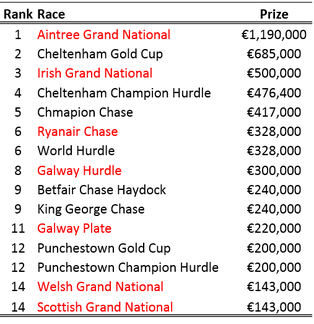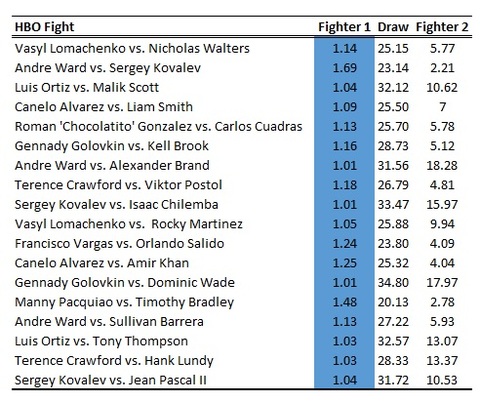We will be taking our usual Christmas break and will return on Monday the 16th of January. We would like to wish all of our readers a happy Christmas and prosperous new year.
|
By Robbie Butler
We will be taking our usual Christmas break and will return on Monday the 16th of January. We would like to wish all of our readers a happy Christmas and prosperous new year. The 3rd annual sportseconomics.org workshop on sport and economics will take place on Friday 21st of July 2017 at University College Cork.
The purpose of the workshop is to discuss and stimulate research ideas from those working in the areas of sports economics, sports management, coaching, public health, and related fields from Ireland and abroad. Further details on the keynote and call for papers will be issued in the New Year. The Organising Committee: David Butler, Robbie Butler, John Eakins By Robbie Butler
Anyone that has ever taken an introductory course in economics will probably have studied competitive markets. Economics textbooks argue that consumers are best served when competition exists amongst sellers. In theory, perfect competition is the best outcome from the consumer, as prices are driven to the point where suppliers are able to cover their average costs and no more. One way for producers to increase prices is to restricted supply. This is not always possible, but in some markets conditions exists to allow producers to do this. The most extreme example is a monopoly. The Forbes List of world's highest-paid athletes provides a really nice example of restriction of supply. Various familiar names appear on the list over the past five years such as LeBron James, Tiger Woods, Lionel Messi and Roger Federer. Each moves places over the period. There is one constant throughout - if Floyd Mayweather fights he will be top of the list. Mayweather has been top in 2012, 2014 and 2015. His absence in 2013 and 2016 was down to inactivity in the ring from May 2012 to May 2013, and retirement. Not only does the boxer top the list, his earnings far exceed the next highest sports star, with the Grand Rapids native earning an estimated $300 last year. One of the ways the boxer is cashing in is by deliberately restricting the supply of fights to the market. Since Christmas 2007 (almost a decade), Mayweather has fought just ten times. The hype that his infrequent reappearance in the ring generates, results in huge box office and pay-per-view broadcasting demand and generates revenues far above more frequently viewed sports stars. As David touched on recently, uncertainty of outcome is largely irrelevant in boxing, yet the undefeated Mayweather finds this no impediment to generating interest in his fights. By Robbie Butler
On Thursday it will be 21 years to the day since the European Court of Justic heard Union Royale Belge des Sociétés de Football Association ASBL v Jean-Marc Bosman (C-415/93). Following the submissions by both sides, the court ruled that the transfer system that existed placed a restriction on the free movement of workers. This was prohibited by Article 39(1) of the Treaty of Rome. The court instructed that all other European Union football players had the right to move freely at the end of their contracts, so long as they were transferring to another club within the European Union. The rest is history. While not directly testable, this had an impact on young Irish players hoping to sign professional contracts in the UK. It's now appears much harder for Irish players to make it at top clubs in the Premier League. As late as the mid-1990s Irish stars populated the top teams, with players contracted to Manchester United, Liverpool, Tottenham, Arsenal, Aston Villa and Chelsea. This is not the case today and is partly down to the global pool of talent open to all clubs in the Premier League. Clubs can, and do, sign players from every continent on the planet. The competition to "make it" is fierce. Brexit may ironically provide an opportunity for Irish players. It is impossible to know what Britain's exit from the EU will look like but already the "special relationship" with Ireland is being mentioned in both the UK and Europe. The House of Lord has mentioned drafting a bilateral agreement, with EU approval, that could apply to citizens on both islands. While this may not be possible, as member states can't make their own agreements with countries outside the EU, special arrangements have not been ruled out. Should the UK restrict the movement of people entering from the EU (migration was cited as the single biggest factor for voting to leave), it is likely the number of EU-born players playing in the Premier League will fall. If Ireland has a "special agreement" it might be possible for players to move more freely. Effectively, it could be an return to conditions similar to those pre-Bosman. Should this opportunity arise it can only be a good thing for Irish players and we may start to see stars emerging again within the confines of Old Trafford, the Emirates and Anfield. Only time will tell. By David Butler In the last post on this website Robbie discussed how uncertainty of outcome is often what drives interest in sport. As he said “contests where the outcome is predictable are often criticised for being boring”. He also notes that “some might argue that watching a dominant champion can increase interest in a sport”. At times people enjoy watching a champion or a well-known star as much as a close contest. Looking at the betting for this weekend’s big boxing fight made me think about this a little more. The betting on the Anthony Joshua v Eric Molina fight currently stands at Joshua 1/50 to win. Molina is 14/1 to succeed and a draw is 50/1. Why would customers pay £16.95/€21.95 for what the markets suggest is a foregone conclusion? When it comes to major boxing matches, uncertainty of outcome rarely seems to influence promoters or those buying the product. The list below shows the average odds for HBO fights in 2016. HBO serves as a distributor of major boxing events for pay-per-view. A clear favorite has existed in almost all of the bouts with the exception of the Sergey Kovalev vs. Andre Ward and Manny Pacquiao vs. Timothy Bradley fights. In all cases the favourite has won (marked in blue below). While the data for subscribers by fight is a little patchier, the relationship between uncertain outcomes and demand seems spurious. From this list, the fight the market priced as the closest contest , Sergey Kovalev vs. Andre Ward, had a reported 160,000 buyers. The fights such as Canelo Alvarez vs. Liam Smith and Canelo Alvarez vs. Amir Khan had 300,000 and 600,000 subscribers respectively.
Naturally, this raises the question of why people shell out cash to view outcomes that are hardly uncertain. Many reasons might exist. Maybe viewers enjoy seeing a dominant champion succeed? Many of the headlines after these bouts use the words 'demolish' or 'crush' to describe the fight. Maybe nationalism is a factor? The Mexicans tune in to see Alvarez and the British follow Khan. Maybe viewers rarely get to see certain fighters or it could be close to the end for one star? Maybe the major broadcasting firms and promoters just do a great marketing job? Maybe fans are risk averse and just don't want to miss what could be a major upset in boxing history? Maybe viewers just don't want to feel out of the loop in the coffee room on Monday morning. The list could go on... By Robbie Butler When watching sport, uncertainty of outcome is often what drives interest. Contests where the outcome is predictable are often criticised for being boring. Although some might argue that watching a dominant champion can increase interest in a sport (think of Tiger Woods or Roger Federer over the past 15 years), almost everyone accepts uncertainty of outcome is desirable at some level. Sports governing bodies employ a variety of techniques in order to increase uncertainty of outcome, with varying levels of success. Some sports are more amenable to levelling the playing field than others. For example, in football financial fair play rules are an attempt to restrict dominate teams from becoming even more powerful. The success of these rules is debatable. A sport where uncertainty of outcome is more readily tackled is horse racing. The most widespread means to generate uncertainty of outcome is through the handicapping process. For those unfamiliar with the sport, each horse has a handicap rating. In Ireland at the moment this is a number between 65 and 177 (see full list here). Don Cossack is the highest rated National Hunt horse running in Ireland today on a rating of 177. In theory, this rating predicts that this horse would beat every other horse in training. In order to overcome the predictability this would bring, handicapping is used, with higher rated horses carrying more weight in races. This process increases uncertainty of outcome, as the ability of the horse is not the only consideration when attempting to predict the outcome of a race.  Sponsors and the public appear to embrace uncertainty of outcome also. Recently my father presented me with a list of the of the top 15 most valuable jump races during the 2016-2017 season (presented to the right). The races marked in red are handicaps. The other races are those where equal weights are carried by all horse (gender concessions still apply). The biggest prize is a handicap – the world famous Aintree Grand National. As is the 3rd biggest (Irish equivalent). In fact, almost half of the list are handicaps. In total the list adds to €5,610,400. The Aintree Grand National is more than 20% of this amount. In total, the seven handicaps are worth €2,824,000 (50.34%). The irony here of course is that the best horses generally don’t run in handicaps. It is difficult to conceive lesser athletes in baseball, football, basketball, rugby, tennis, golf, etc. playing for more prize money than elite athletes. This just does not happen. The best players play for the biggest prizes. Incentives prevent handicapping of this sort being introduced in most human sports as it would act as a disincentive to top performers. Horse racing is fortunate in this regard and interest in handicap races on these islands is as popular as ever. In fact, given the distriubtion of prizemoney above it's likely 'better' horses will appear more frequently in handicaps in the months ahead. |
Archives
June 2024
About
This website was founded in July 2013. Categories
All
|

 RSS Feed
RSS Feed